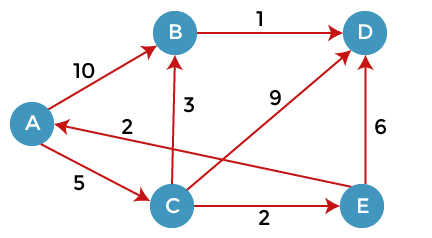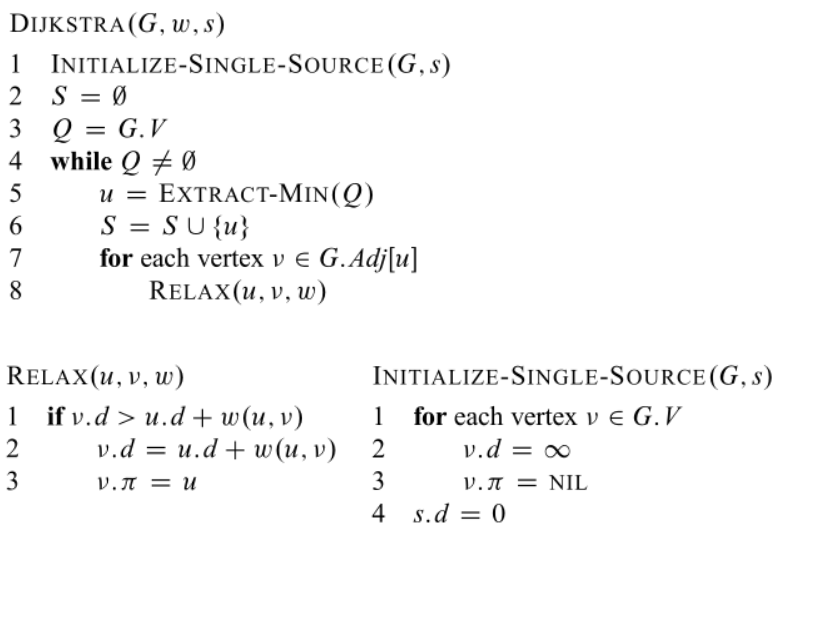It is a greedy algorithm that solves the single-source shortest path problem for a directed graph G = (V, E) with nonnegative edge weights, i.e., w (u, v) ≥ 0 for each edge (u, v) ∈ E.
Dijkstra's Algorithm maintains a set S of vertices whose final shortest - path weights from the source s have already been determined. That's for all vertices v ∈ S; we have d [v] = δ (s, v). The algorithm repeatedly selects the vertex u ∈ V - S with the minimum shortest - path estimate, insert u into S and relaxes all edges leaving u.
Because it always chooses the "lightest" or "closest" vertex in V - S to insert into set S, it is called as the greedy strategy.
Here is an example of Dijkstra's Algorithm
Let's consider the directed graph.

Here, we consider A as a source vertex. A vertex is a source vertex so entry is filled with 0 while other vertices filled with ∞. The distance from source vertex to source vertex is 0, and the distance from the source vertex to other vertices is ∞.
We will solve this problem using the below table:
A | B | C | D | E |
∞ | ∞ | ∞ | ∞ | ∞ |
Since 0 is the minimum value in the above table, so we select vertex A and added in the second row shown as below:
A | B | C | D | E | |
A | 0 | ∞ | ∞ | ∞ | ∞ |
As we can observe in the above graph that there are two vertices directly connected to the vertex A, i.e., B and C. The vertex A is not directly connected to the vertex E, i.e., the edge is from E to A. Here we can calculate the two distances, i.e., from A to B and A to C. The same formula will be used as in the previous problem.
A | B | C | D | E | |
A | 0 | ∞ | ∞ | ∞ | ∞ |
10 | 5 | ∞ | ∞ |
As we can observe in the third row that 5 is the lowest value so vertex C will be added in the third row.
We have calculated the distance of vertices B and C from A. Now we will compare the vertices to find the vertex with the lowest value. Since the vertex C has the minimum value, i.e., 5 so vertex C will be selected.
Since the vertex C is selected, so we consider all the direct paths from the vertex C. The direct paths from the vertex C are C to B, C to D, and C to E.
First, we consider the vertex B. We calculate the distance from C to B. Consider vertex C as 'x' and vertex B as 'y'.
d(x, y) = d(x) + c(x, y) < d(y)
= (5 + 3) < ∞
= 8 < ∞
Since 8 is less than the infinity so we update d(B) from ∞ to 8. Now the new row will be inserted in which value 8 will be added under the B column.
A | B | C | D | E | |
A | 0 | ∞ | ∞ | ∞ | ∞ |
10 | 5 | ∞ | ∞ | ||
8 |
We consider the vertex D. We calculate the distance from C to D. Consider vertex C as 'x' and vertex D as 'y'.
d(x, y) = d(x) + c(x, y) < d(y)
= (5 + 9) < ∞
= 14 < ∞
Since 14 is less than the infinity so we update d(D) from ∞ to 14. The value 14 will be added under the D column.
A | B | C | D | E | |
A | 0 | ∞ | ∞ | ∞ | ∞ |
C | 10 | 5 | ∞ | ∞ | |
8 | 14 |
We consider the vertex E. We calculate the distance from C to E. Consider vertex C as 'x' and vertex E as 'y'.
d(x, y) = d(x) + c(x, y) < d(y)
= (5 + 2) < ∞
= 7 < ∞
Since 14 is less than the infinity so we update d(D) from ∞ to 14. The value 14 will be added under the D column.
A | B | C | D | E | |
A | 0 | ∞ | ∞ | ∞ | ∞ |
C | 10 | 5 | ∞ | ∞ | |
8 | 14 | 7 |
As we can observe in the above table that 7 is the minimum value among 8, 14, and 7. Therefore, the vertex E is added on the left as shown in the below table:
A | B | C | D | E | |
A | 0 | ∞ | ∞ | ∞ | ∞ |
C | 10 | 5 | ∞ | ∞ | |
E | 8 | 14 | 7 |
The vertex E is selected so we consider all the direct paths from the vertex E. The direct paths from the vertex E are E to A and E to D. Since the vertex A is selected, so we will not consider the path from E to A.
Consider the path from E to D.
d(x, y) = d(x) + c(x, y) < d(y)
= (7 + 6) < 14
= 13 < 14
Since 13 is less than the infinity so we update d(D) from ∞ to 13. The value 13 will be added under the D column.
A | B | C | D | E | |
A | 0 | ∞ | ∞ | ∞ | ∞ |
C | 10 | 5 | ∞ | ∞ | |
E | 8 | 14 | 7 | ||
B | 8 | 13 |
The value 8 is minimum among 8 and 13. Therefore, vertex B is selected. The direct path from B is B to D.
d(x, y) = d(x) + c(x, y) < d(y)
= (8 + 1) < 13
= 9 < 13
Since 9 is less than 13 so we update d(D) from 13 to 9. The value 9 will be added under the D column.
A | B | C | D | E | |
A | 0 | ∞ | ∞ | ∞ | ∞ |
C | 10 | 5 | ∞ | ∞ | |
E | 8 | 14 | 7 | ||
B | 8 | 13 | |||
D | 9 |
Disadvantage of Dijkstra's Algorithm:
- It does a blind search, so wastes a lot of time while processing.
- It can't handle negative edges.
- It leads to the acyclic graph and most often cannot obtain the right shortest path.
- We need to keep track of vertices that have been visited.






No comments:
Post a Comment